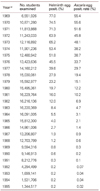Abstract
The transition of important parasitic diseases in Korea is briefly reviewed in this article. Soil-transmitted helminthiases, such as ascariasis, trichuriasis, and hookworm infections, which had been prevalent all over the country, decreased remarkably, largely owing to the national control activities by means of mass examination-mass treatment schemes for school students. Paragonimiasis has shown significant reduction in its incidence, but clonorchiasis still remains as an important health-threatening trematode infection. Intestinal trematodiases, including metagonimiasis, heterophyidiases, and echinostomiases are prevalent, and new species, such as Gymonphalloides seoi and Neodiplostomum seoulense, have been documented as new human parasitic diseases. Tapeworm infections including larval cestodiases are also decreasing. Among the protozoan infections, amebiasis and malaria showed an apparent decreasing trend, but in recent years, vivax malaria has become a re-emerging disease. Brugian filariasis, which was prevalent in southern parts of the Korean peninsula, has been completely eliminated nowadays. In terms of the prevalence and distribution, clonorchiasis, enterobiasis, and vivax malaria are currently the major parasitoses of public health importance in Korea.
Figures and Tables
References
1. Han ET, Guk SM, Kim JL, Jeong HJ, Kim SN, Chai JY. Detection of parasite eggs from archaeological excavations in the Republic of Korea. Mem Inst Oswaldo Cruz. 2003. 98:S1. 123–126.

2. Seo M, Guk SM, Kim JH, Chai JY, Bok GD, Park SS, Oh CS, Kim MJ, Yi YS, Shin MH, Kang IU, Shin DH. Paleoparasitological report of the stool from a medieval child mummy in Yangju. Korean J Parasitol. 2007. 93:589–592.

3. Mills RG. A contribution to nosogeography of northern Korea. China Med J. 1911. 25:277–293.
4. Seo HG, Hwang SI, Chai JY. Study on the transition of intestinal parasites in Korea from 1913 to 1989. Korean J Med Hist. 1992. 1:45–63. (in Korean).
5. Lee SH. Twenty-year history of The Korean Society for Parasitology. Korean J Parasitol. 1979. 17:183–196. (in Korean).
6. Kobayashi H. Parasitic and endemic diseases in Chosen. Mitt Med Akad Keijo. 1926. 9:67–76.
7. Yun IS. Elephantiasis due to filaria in Korea. Chosen Iggakai Zasshi. 1927. 76:326–334. (in Japanese).
8. Hunter GWIII, Ritchie LS, Chang IC, Rolph WD, Manson HC Jr, Szewczak J. Parasitological studies in the Far East VII. An epidemiological survey in southern Korea. J Parasitol. 1949. 35:S6. 41.
9. Hong ST, Chai JY, Choi MH, Huh S, Rim HJ, Lee SH. A successful experience of soil-transmitted helminth control in the Republic of Korea. Korean J Parasitol. 2006. 44:177–185.

10. Seo BS, Rim HJ, Loh IK, Lee SH, Cho SY, Park SC, Bae JW, Kim JH, Lee JS, Koo BY, Kim KS. Study on the status of helminthic infections in Koreans. Korean J Parasitol. 1969. 7:53–70. (in Korean).

11. Seo BS. Ascariasis and its control problems. Seoul J Med. 1981. 22:323–341.
12. Seo BS, Lee SH, Cho SY, Chai JY, Hong ST, Han IS, Sohn JS, Cho BH, Ahn SR, Lee SK, Chung SC, Kang KC, Shim HS, Hwang IS. An epidemiologic study on clonorchiasis and metagonimiasis in riverside areas in Korea. Korean J Parasitol. 1981. 19:137–150.

13. Rim HJ. The current pathobiology and chemotherapy of clonorchiasis. Korean J Parasitol. 1986. 24:S. 1–141.

14. Korea Association of Health Promotion. Prevalence of intestinal parasitic infections in Korea (the 7th report). 2004. Seoul, Korea: KAHP;37–38.
15. Chai JY, Lee SH. Food-borne intestinal trematode infections in the Republic of Korea. Parasitol Int. 2002. 51:129–154.

16. Seo BS, Lee SH, Hong ST, Hong SJ, Kim CY, Lee HY. Studies on intestinal trematodes in Korea V. A human case infected by Fibricola seoulensis (Trematoda: Diplostomatidae). Korean J Parasitol. 1982. 20:93–99.

17. Lee SH, Chai JY, Hong ST. Gymnophalloides seoi n. sp. (Digenea: Gymnophallidae), the first report of human infection by a gymnophallid. J Parasitol. 1993. 79:677–680.

18. Chai JY, Choi MH, Yu JR, Lee SH. Gymnophalloides seoi: a new human intestinal trematode. Trends Parasitol. 2003. 19:109–112.
19. Eom KS, Rim HJ. Morphologic descriptions of Taenia asiatica sp. n. Korean J Parasitol. 1993. 31:1–6.
20. Lee SH. Study on the status of intestinal protozoan infections in Koreans. J Health Fellowship Found. 1973. 3:1–6. (in Korean).
22. Paik YH, Rhee HI, Shim JC. Malaria in Korea. Kyung Hee Univ Med J. 1987. 12:17–31.
23. Han ET, Lee DH, Park KD, Seok WS, Kim YS, Tsuboi T, Shin EH, Chai JY. Reemerging vivax malaria: changing patterns of annual incidence and control programs in the Republic of Korea. Korean J Parasitol. 2006. 44:285–294.

25. National Institute of Health, Center for Disease Control and Prevention, MOH, Korea. Elimination of lymphatic filariasis in Korea. 2007. Seoul, Korea: National Documentation for Certification (a monograph).




 PDF
PDF ePub
ePub Citation
Citation Print
Print




 XML Download
XML Download